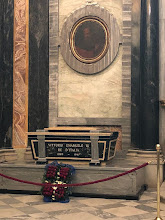Antonio Stradivari – violin maker
Craftsman from Cremona produced the world’s best stringed instruments
The man who produced violins worth millions, Antonio Stradivari, died at the age of 93 on this day in Cremona in 1737. Stradivari was an ordinary man who worked as a luthier, a maker of stringed instruments, but experts now consider him to be the greatest ever in his field. He is believed to have produced more than 1,100 instruments, often referred to as 'Stradivarius' violins. About 650 of them are still in existence today and in the last few years some of his violins and violas have achieved millions of dollars at auction. The Stradivari family date back to the 12th century in Cremona and it is believed Antonio was born there in 1644. It is thought he was apprenticed to the violin maker Nicolò Amati. The label on the oldest violin still in existence, known to have been made by Stradivari, bears the date 1666. He had enough money to buy a house for himself and his family in Cremona by 1680. He used the attic as a workshop and kept producing better and better instruments until his reputation spread beyond Cremona. In 1688 a Venetian banker ordered a set of instruments to present to King James II of England. Read more…
____________________________________
Mara Carfagna - politician
Former glamour model now important voice in Italian parliament
The politician Mara Carfagna, a one-time glamour model and TV hostess who became vice-president of the Chamber of Deputies in the Italian parliament, was born on this day in 1975 in Salerno. Originally named Maria Rosaria Carfagna, she left high school to study dance at the school of the Teatro San Carlo in Naples, obtaining a diploma before going on to study acting and the piano. In 1997 she won a beauty contest as Miss 1997 and participated in the finals of Miss Italia. She had her first experience in television as one of the co-presenters during the 1997-98 season of the Rai variety show, Domenica In, with Fabrizio Frizzi. Carfagna found herself in demand as a model and posed for some magazine and calendar shoots, but at the same time was studying law at the University of Salerno, graduating with honours in 2001. More television work came her ways as a glamourous co-presenter of the Mediaset show La domenica del villaggio alongside Davide Mengacci, moving on to present another entertainment show Piazza grande together with Giancarlo Magalli. Read more…
____________________________________
Camillo Castiglioni - business entrepreneur
Young man from Trieste who reached for the skies
Camillo Castiglioni, a financier and aviation pioneer once reputed to be the wealthiest man in Central Europe, died on this day in 1957 in Rome. Castiglioni was an Italian-Austrian banker who played a big part in the early days of aviation and also invested his wealth in the arts. He was born in Trieste in 1879, when the port on the Adriatic, now firmly established as part of Italy, fell within the boundaries of Austria-Hungary. His father, Vittorio, was a prominent figure in the large Jewish community in Trieste, where he was vice-rabbi, and there were hopes that Camillo might also become a rabbi. But after being educated in the law and working as an attorney and legal officer in a bank in Padua, where he quickly learnt about international finance and how to manage capital, it was clear his focus would be business. Vittorio had been a rubber manufacturer and his son soon enjoyed financial success working as an agent in Vienna for a tyre maker in Constantinople. He made good contacts both in business circles and the imperial court in Vienna, becoming a personal friend of the young Archduke Charles. Read more…
________________________________________
Gianluca Pagliuca – record-breaking goalkeeper
No one has saved more penalties in Serie A matches
The footballer Gianluca Pagliuca, once the most expensive goalkeeper in the world, record-holder for the most appearances by a goalkeeper in the Italian soccer championship and still the stopper with the most penalty saves in Serie A, was born on this day in 1966 in Ceretolo, a small town about 10km (6 miles) from the centre of Bologna. Pagliuca made 592 appearances in Serie A, taking the record previously held by Italy’s World Cup-winning captain Dino Zoff for the most by a goalkeeper in the top division of the Italian League. He held the record for 10 years from September 2006 until it was overtaken by another of Italy’s greatest goalkeepers, Gianluigi Buffon, in 2016. He played for four major clubs in his career, starting with Sampdoria, with whom he won the Serie A title – the Scudetto – in 1990-91, playing in the team that included Gianluca Vialli, Roberto Mancini, Beppe Dossena, Attilio Lombardo and Ivano Bonetti. After Sampdoria, he represented Internazionale in Milan, his home-town club Bologna and the small club Ascoli, from Ascoli Piceno in Marche. He also made 39 appearances for the Italian national team. Read more…


.jpg)

.jpg)

.jpg)









.jpg)

.jpg)


.jpg)
.jpg)
.jpg)
.jpg)
.jpg)


.jpg)

.jpg)

.jpg)

